- 10 Minutes to read
- Print
- DarkLight
- PDF
Migrating a File Server to a CTERA Edge Filer
- 10 Minutes to read
- Print
- DarkLight
- PDF
You can migrate a file server to the CTERA Edge Filer. After the migration has completed, end users who are familiar with a given folder structure and shares, as well as a given permission scheme continue to see the same folder structure, shares, and permission scheme. This enables the migration from a current file system to the CTERA Edge Filer without the need to apply any structural changes such as flattening the folder structure or simplifying the permissions scheme.
You can migrate file servers including Windows File Server, NetApp ONTAP, Panzura Freedom Filer.
Access to files and folders after the migration is through SMB provided by the CTERA Edge Filer so that users continue to access the files and folders in the same way as with the old system. You can migrate more storage than is physically available on the CTERA Edge Filer and the user has access to the global namespace, even when this is much larger than the storage available on the CTERA Edge Filer.
You can migrate a single file server to the CTERA Edge Filer as a single cloud folder. After the migration, the cloud folder will start with the C: path as it represents a single server with all the shares/nested shares.
Migrating a file server to a CTERA Edge Filer can be performed while the current file server remains in production.
The flow when performing a migration is as follows:

Migrating a File Server to the CTERA Edge Filer
Before migrating the file server to the CTERA Edge Filer, the CTERA Edge Filer must be connected to the CTERA Portal. After finishing the initial setup, make sure that syncing between the CTERA Edge Filer and CTERA Portal is not suspended.
To migrate a single file server to the CTERA Edge Filer as a single cloud folder involves the following procedures:
Discovering Shares – Optionally survey the current file server to discover which shares to migrate.
Migrating Shares – Migration shares to the CTERA Edge Filer.
After the migration, the cloud folder will start with the C: path as it represents a single server with all the shares/nested shares.
Special characters in share names are not supported by the Migration tool. When such characters are used, the share contents are not migrated. This condition is reported, and the job is Completed with errors.
Discovering Shares
To discover the shares to migrate:
In the Configuration view, select Main > Welcome in the navigation pane.
The Welcome page opens, displaying the product information.
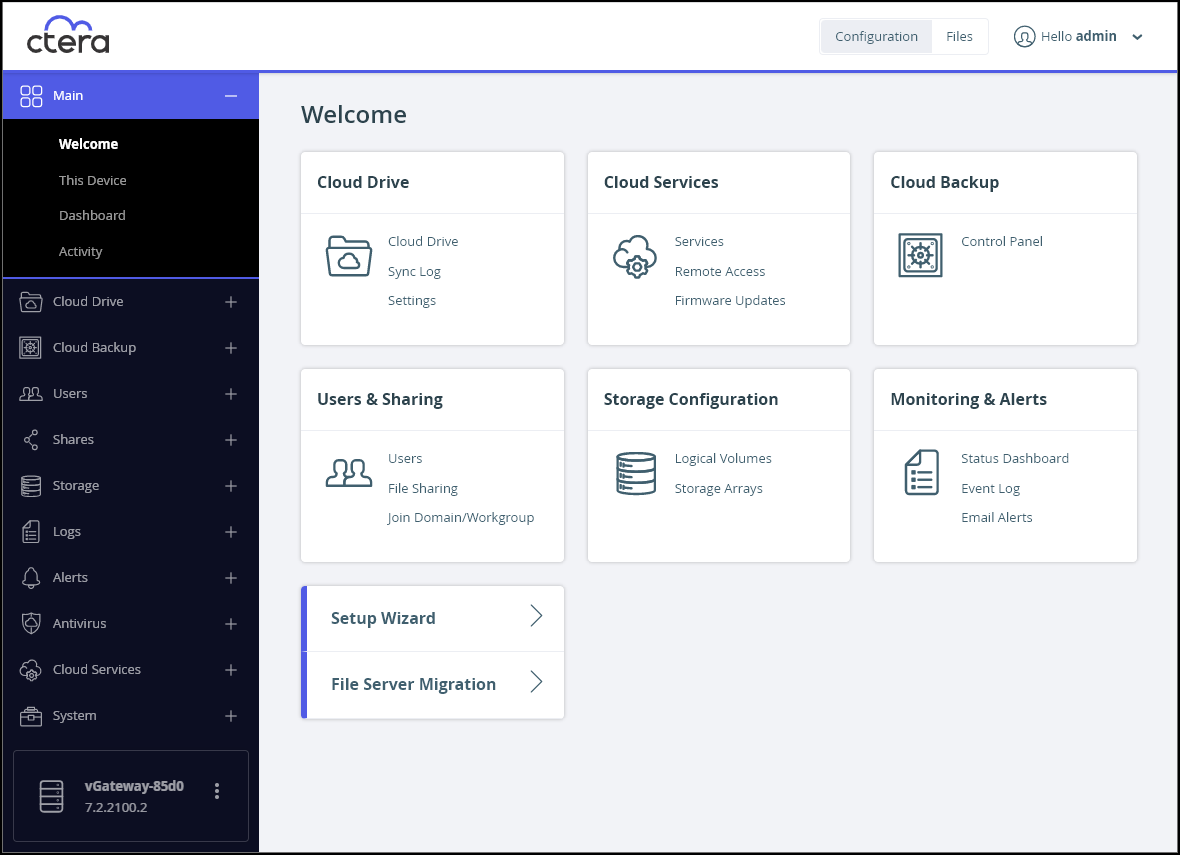
Click File Server Migration.
The File Server Migration page is displayed.
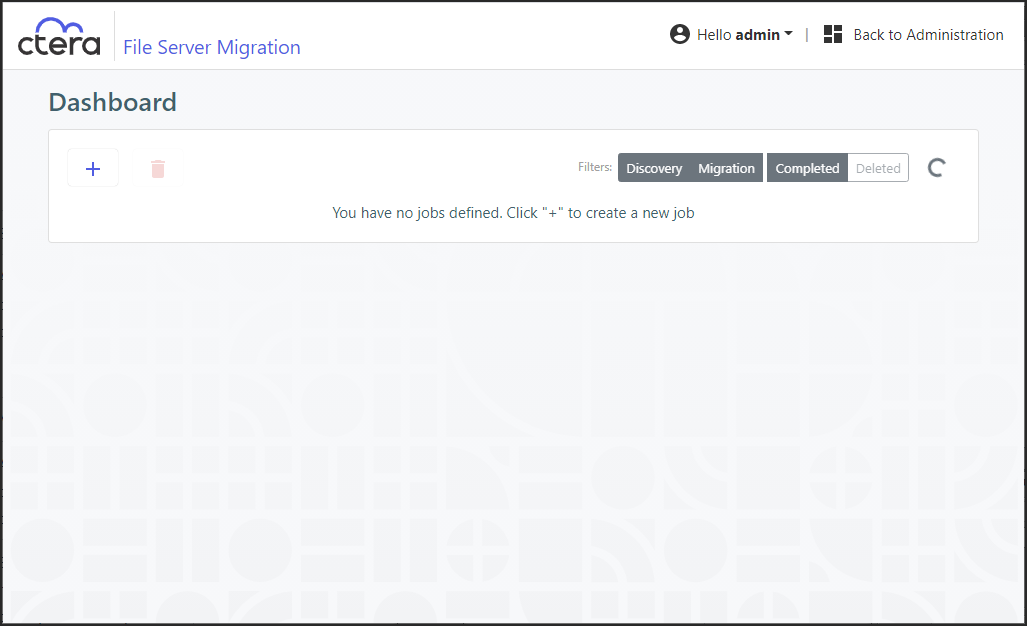
Click + to create a new job.
The Create Discovery Job wizard is displayed showing the Task Type step.
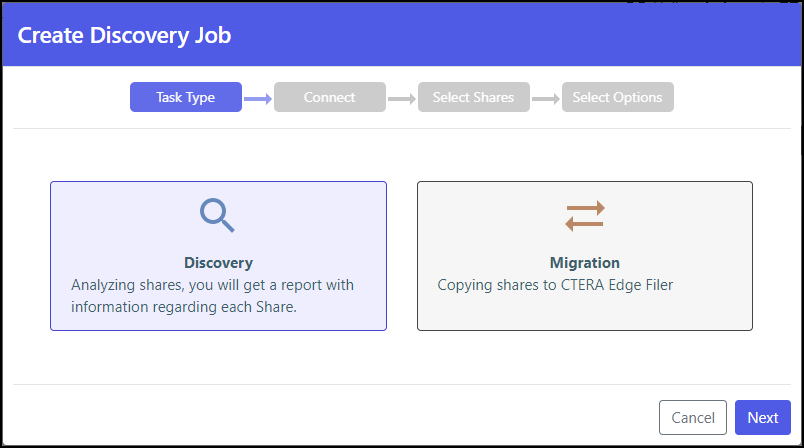
The default job is a Discovery job. This job analyses the file server that is being replaced to identify what data should be migrated.Click Next.
The Connect step is displayed.
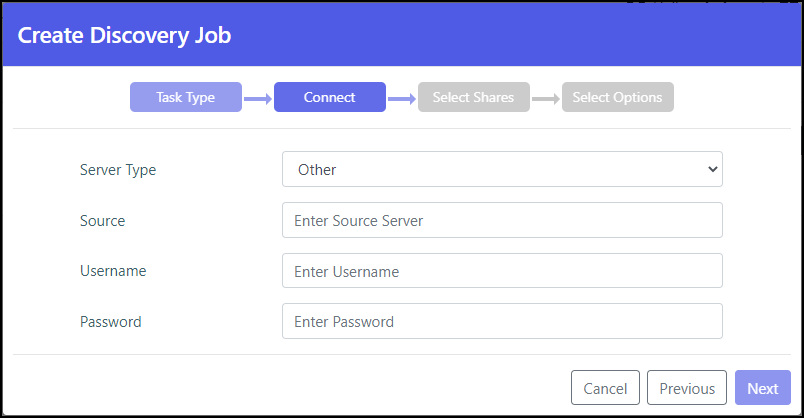
Select the server type to connect to from the drop-down box. You can connect to a Windows Server, NetApp ONTAP, Isilon OneFS, Panzura Freedom Filer, NetAPP StorageGRID 9 (SMB), and NetAPP StorageGRID1 (SMB), or another file server by selecting the Other option.
You can also run discovery on the edge filer itself, by selecting This Edge Filer for Server Type.Enter the IP address or DNS name for the source file server and an administrator user name and password to access this server.
NoteThe administrator used must have access to the files to migrate.
Click Next.
The Select Shares step is displayed.

The shares on the file server are displayed and you can select the shares that you want to migrate to the CTERA Edge Filer.Select the shares to migrate and click Next.
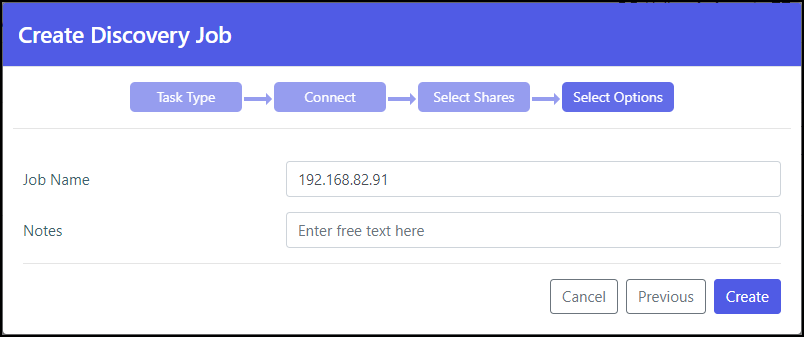
Optionally, provide a different name for the job and any specific notes about the job.
Click Create.
After analyzing the file server the job completes and you get a report as well as a full analysis of each share in the filer server that you selected.
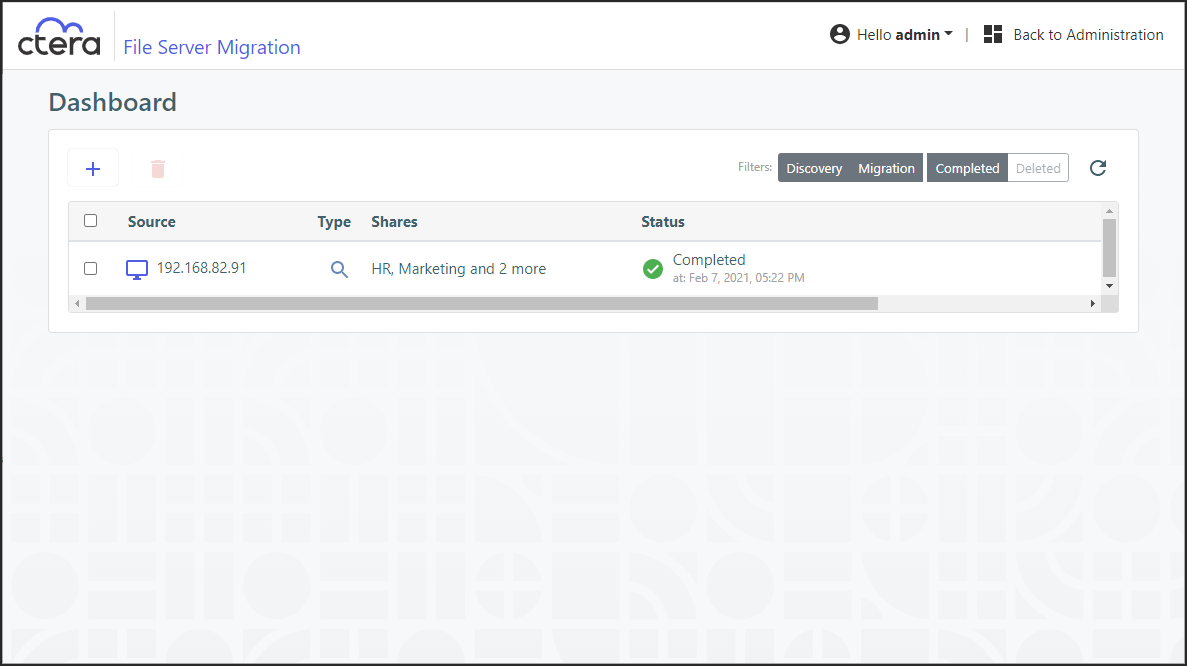
If needed, scroll to the end of the job for buttons to access the discovery report and shares details.Click
 to edit the discovery job name and notes.
to edit the discovery job name and notes.

Click
 to display the discovery report.
to display the discovery report.

At the top of the window the sum of the information for the selected shares is displayed.
The first pane in the discovery report shows the list of shares with details of each share:- The number of folders in the selected shares.
- The number of files in the selected shares.
- The size of the selected shares.
- The status of the report for the selected shares.
- The source file server type.
- Whether Log Every File (Verbose Logging), in step 7, was checked.
- Optionally, click
 to download the discovery report as a .csv file.
to download the discovery report as a .csv file.
The second pane in the discovery report has tabs showing the following:
Files – A pie chart with the sizes of the files in the selected shares.
Last Access – A bar chart showing when the files in the selected shares were last accessed.
Last Modified – A bar chart showing when the files in the selected shares were last modified.
File Types – The list of the file types in the selected shares.- If Log Every File (Verbose Logging) is checked, any errors in the discovery job are written to a separate log, under
/errorlog. Each share with an error has a separate log file. Clicking downloads the log file as a .csv file.
downloads the log file as a .csv file.

Click
 to display the list of every time this job was run with the results of each run.
to display the list of every time this job was run with the results of each run.
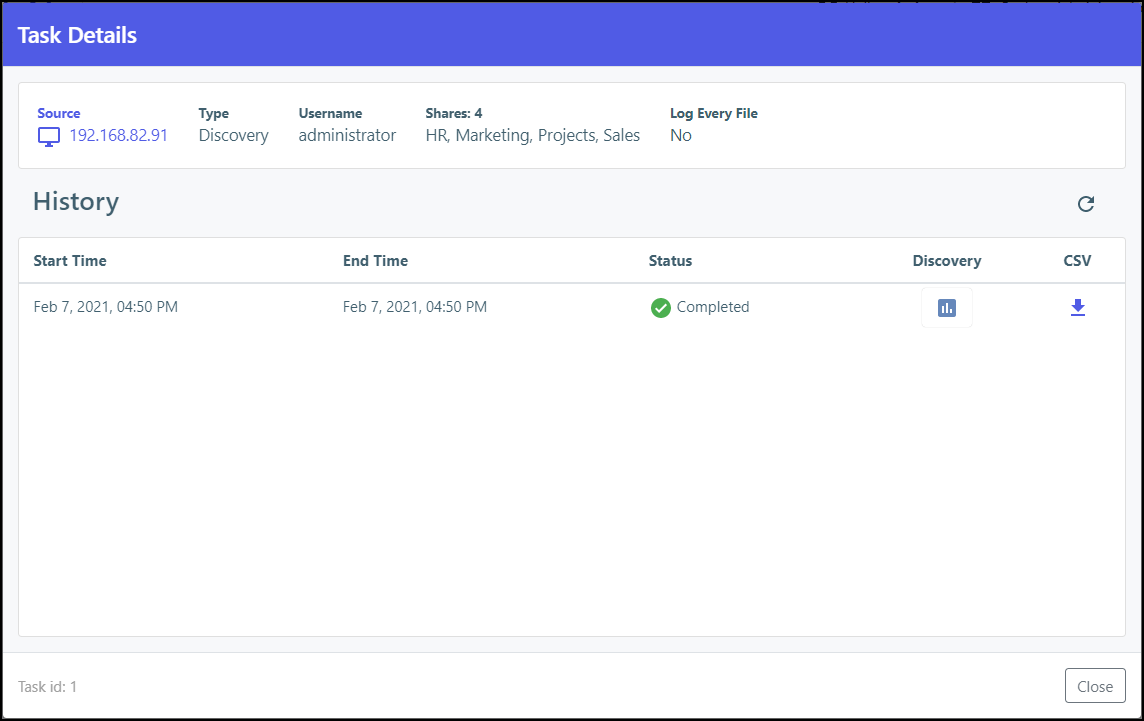 Note
NoteLog files and discovery file lists generated by the Filer Server Migration are compressed if they are greater than 100MB.
Click
 to rerun the discovery.
to rerun the discovery.
The discovery job reruns.Optionally, in the dashboard you can select a job and click
 to delete the job.
to delete the job.
After deleting a job, you can display all the jobs including the deleted jobs by clicking the Deleted filter in the dashboard.

You can restore deleted jobs by selecting the deleted jobs to restore and clicking .
.
Migrating Shares
To migrate shares to the CTERA Edge Filer:
In the Configuration view, select Main > Welcome in the navigation pane.
The Welcome page opens, displaying the product information.
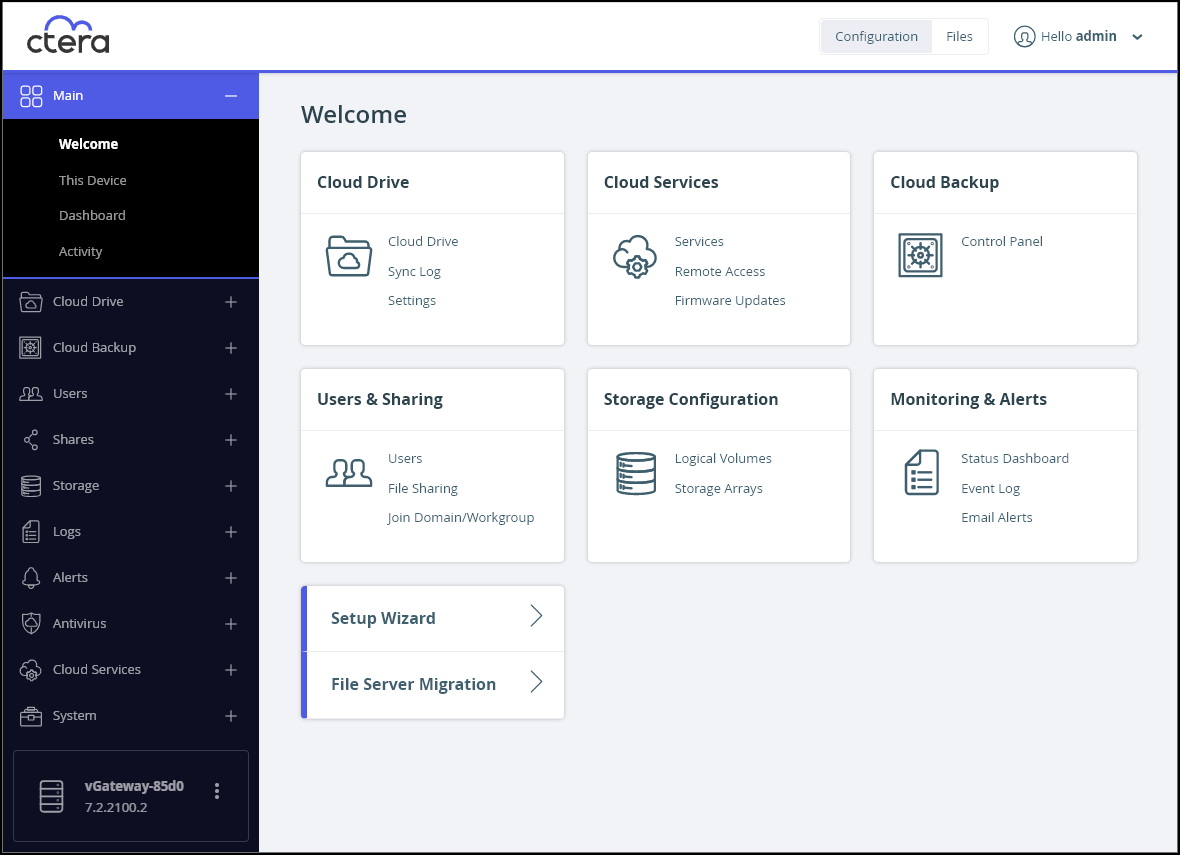
Click File Server Migration.
The File Server Migration page is displayed.

Click + to create a new job.
The Create Discovery Job wizard is displayed showing the Task Type step.

The default job is a discovery job.Click the Migration job to change the job to migrate a file server.
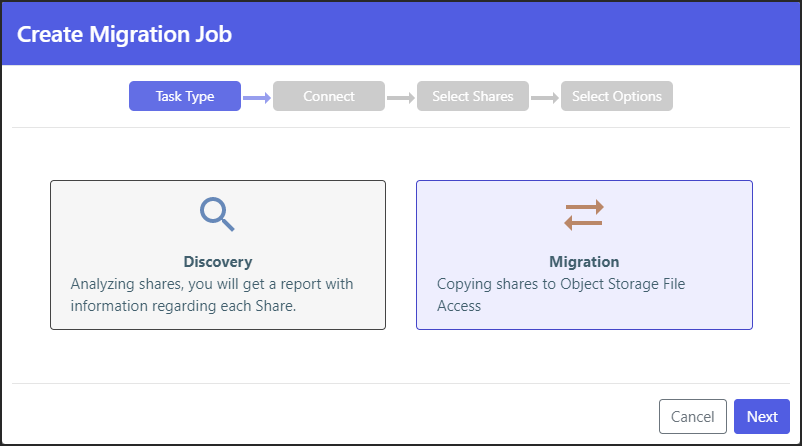
Click Next.
The Connect step is displayed.

Select the server type to connect to from the drop-down box. You can connect to a Windows Server, NetApp ONTAP, Isilon OneFS, Panzura Freedom Filer, NetAPP StorageGRID 9 (SMB), and NetAPP StorageGRID1 (SMB), or another file server by selecting the Other option.
Enter the IP address or DNS name for the source file server and an administrator user name and password to access the filer server.
NoteThe administrator used must have access to the files to migrate.
Click Next.
The Select Shares step is displayed.

Select the shares to migrate and click Next.
The Select Options step is displayed.
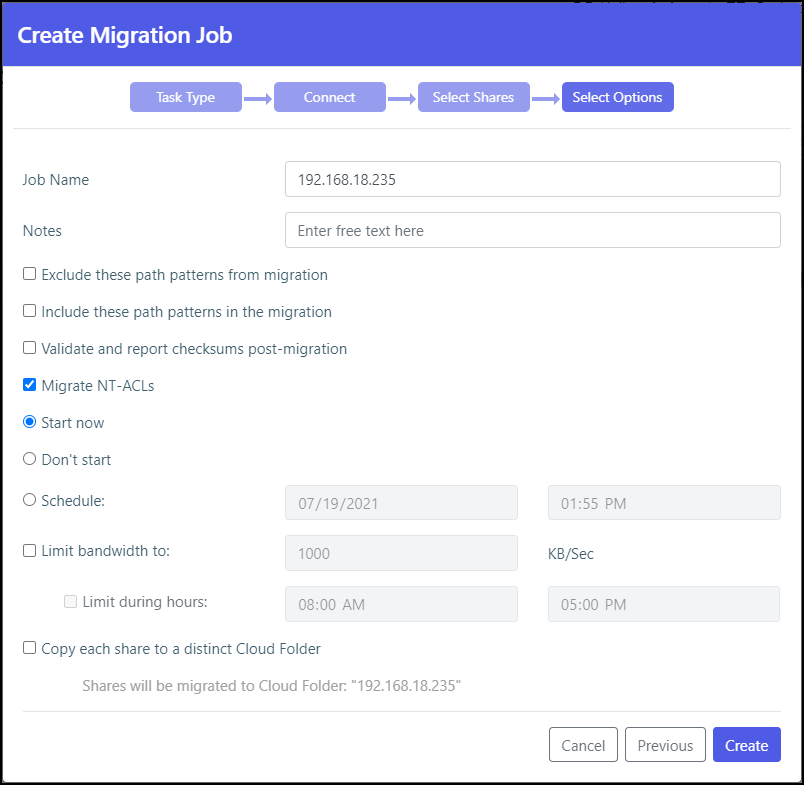
Optionally, provide a different name for the job and any specific notes about the job.
You can specify patterns that you do not want to migrate, or that you do want to migrate, separating each pattern with a colon (:). You can include the asterisk (*) as a wildcard in the pattern. To specify the pattern, check the relevant box.
- Exclude these path patterns from the migration (use the colon character (’:’) as a separator)
- Include these path patterns in the migration (use the colon character (’:’) as a separator)
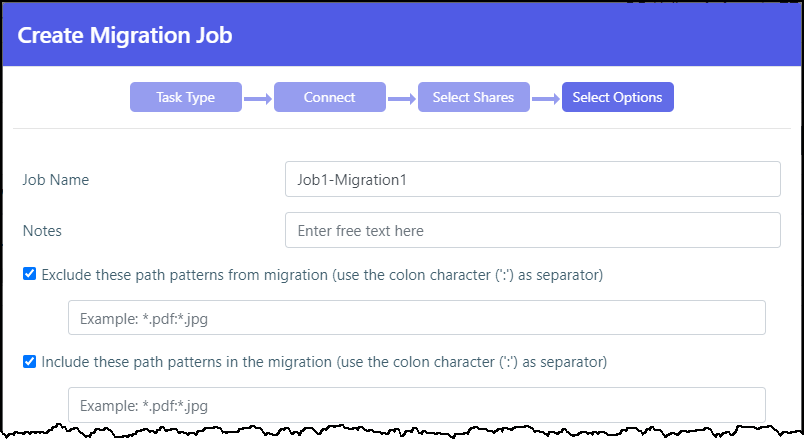
To migrate specific folders in a share, instead of all the folders in the share:- Include the folders by specifying each folder path.
Check Validate and report checksums post-migration to include an MD5 hash checksum for every file being migrated to verify the migration was successful when the hash is compared with the checksum of the file in the source file server.
You can select to migrate the data from the file server with the ACLs.
You can specify when to start the migration, either immediately or at a scheduled date and time.
You can throttle the bandwidth used for the migration with the time range to apply this throttling so as not to adversely impact ongoing work.
Check Copy each share to a distinct Cloud Folder if you want to specify that each share is migrated to a distinct cloud folder.
The cloud folder where the cloud folders are migrated is displayed under the Copy each share to a distinct Cloud Folder checkbox.When Copy each share to a distinct Cloud Folder is checked:
- Jobs that were created in a previous version will continue to migrate into the cloud folder root directory.
- New jobs will create a redundant directory with the name of the source share into the cloud folder root directory, and migrate into it instead.
When Copy each share to a distinct Cloud Folder is not checked:
- Depending on the source exposing the data, either the full path in the original server is recreated and no files are migrated into the cloud folder root, or the share name is used under the cloud folder root as was the case in previous versions.
Click Create.
During the migration, the progress bar shows the percentage completed and what is currently being processed.
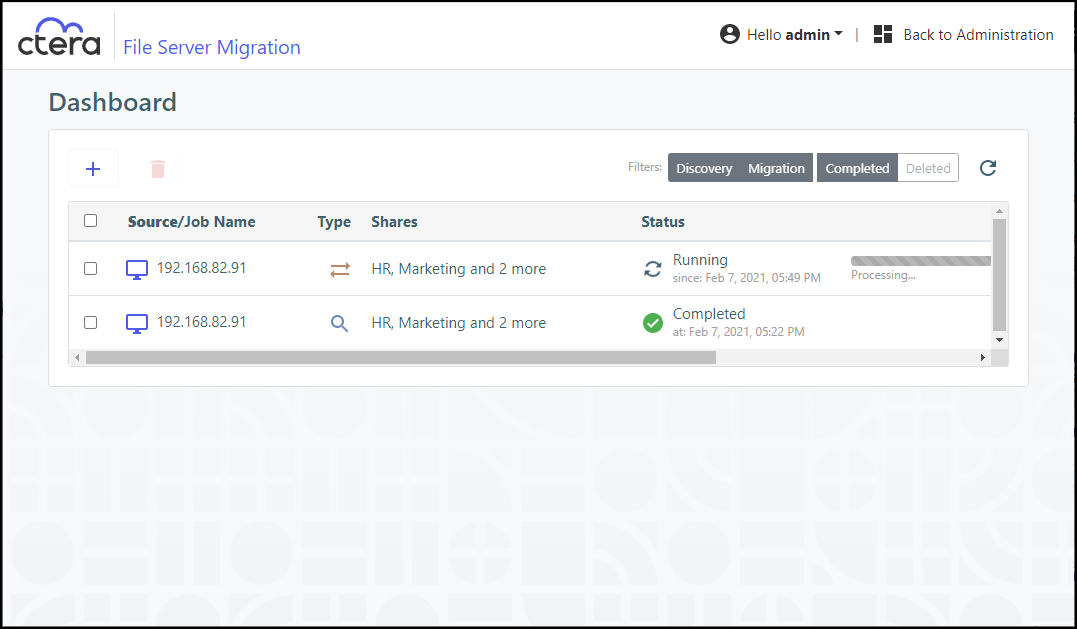
After migrating all the shares, the job completes and an email alert is sent with the job summary.
If needed, scroll to the end of the job for buttons to access the migration report and shares details.

Click
 to edit the migration job name, notes, include and exclude paths, migration checksum schedule and throttling.
to edit the migration job name, notes, include and exclude paths, migration checksum schedule and throttling.
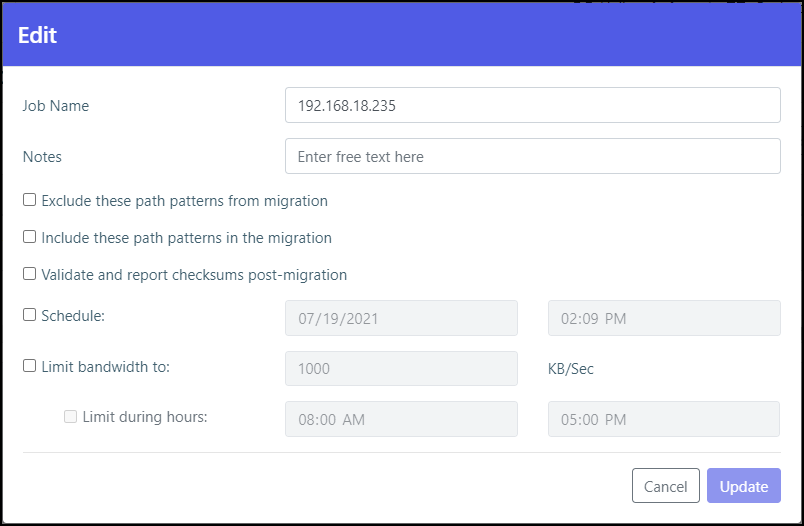
Click
 to display the migration report.
to display the migration report.
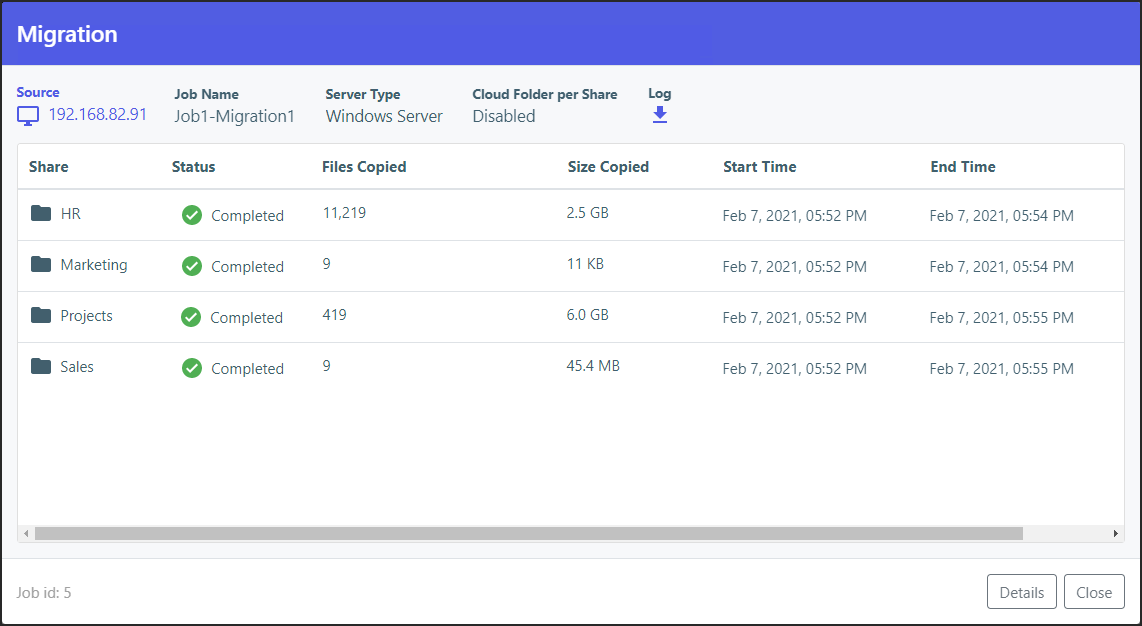
- Optionally, click
 to download the migration log file to a .log text file.
to download the migration log file to a .log text file.
- Optionally, click
Click
 to display the list of every time this job was run with the results of each run, including the start and end times for the job, the number of files migrated and the total size of the migration, access to the report and the ability to download the log, which provides information about the migration and any errors that occurred during the migration.
to display the list of every time this job was run with the results of each run, including the start and end times for the job, the number of files migrated and the total size of the migration, access to the report and the ability to download the log, which provides information about the migration and any errors that occurred during the migration.Optionally, in the dashboard you can select a job and click
 to delete it.
to delete it.
After deleting a job, you can display all the jobs including the deleted jobs by clicking the Deleted filter in the dashboard.
You can restore deleted jobs by selecting the deleted jobs to restore and clicking .
.
The share structure from the source is recreated on the CTERA Edge Filer, including nested shares and their permissions. If there are any recoverable errors during the copy process, retry the migration for the failed shares.
Only ACLs are migrated with the files. Extended attributes are not migrated. In the CTERA Edge Filer the shares are defined with Windows ACL Emulation Mode, as in the following example.

Unless the migration is completed when there is no access to the original file server, after completing the migration there may well be a number of new or changed files on the original file server that require migrating. Continue the migration process using the following procedure.
To complete a migration:
- During off-peak hours, disconnect the filer server.
- In the CTERA Edge Filer user interface, pin the folders that you want to remain local to the CTERA Edge Filer.
- In the Configuration view, select Cloud Drive > Pinned Folders in the navigation pane.
The Pinned Folders page is displayed.
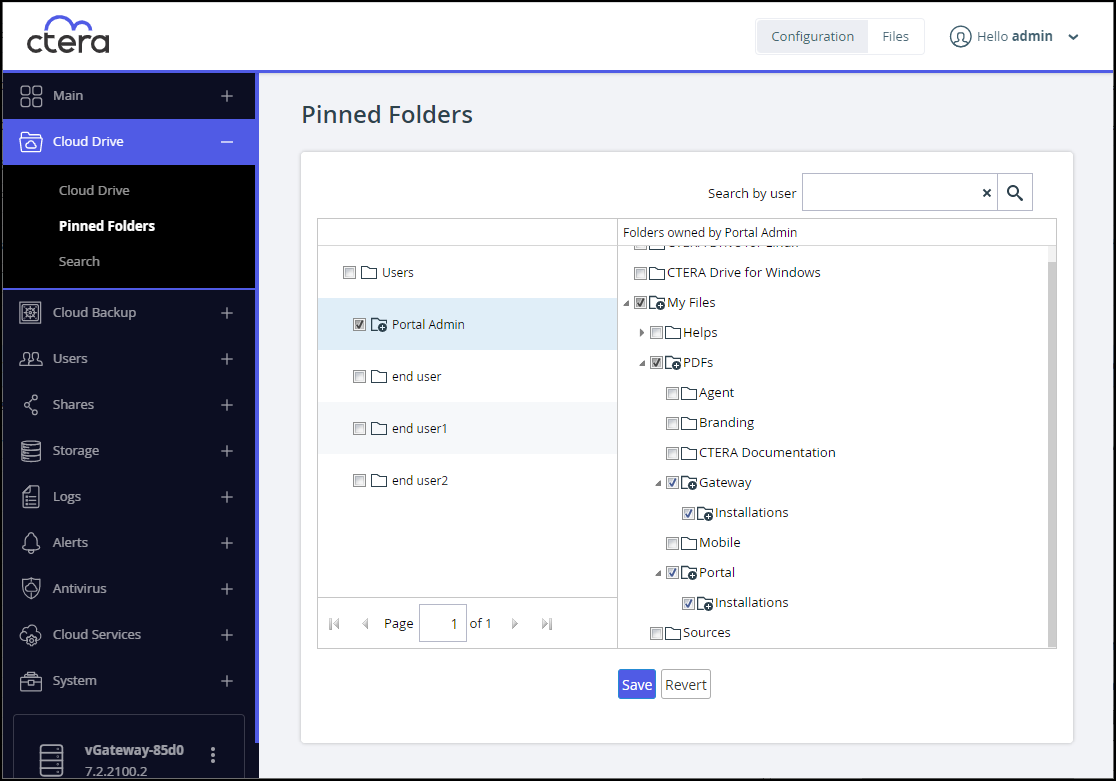
The Pinned Folders area is separated into a users pane and folders pane, with paging in the users pane. This makes it easier to page through the users and select the folders to pin. - Select a user to display the folders owned by the user and then select the folders that you want pinned for this user, so that the folder content is always available on the CTERA Edge Filer.
In addition, you can use the search field to jump to a specific user.NoteYou can select a a user to select all the folders and subfolders owned by the user. You can also select a higher level folder to select all the subfolders under it and then uncheck specific folders to unpin them. If you check a cloud folder, all the subfolders under the cloud folder are pinned and any folders added later under the cloud folder will be pinned automatically.
- Click Save.
The checked folders are pinned.
- In the Configuration view, select Cloud Drive > Pinned Folders in the navigation pane.
- In the Configuration view's Main > Welcome page, click File Server Migration.
The File Server Migration page is displayed showing the discover and migration jobs previously run. - Select the migration job to rerun and click
 .
.
The migration reruns, migrating the deltas from the last migration.
Direct all the users to the CTERA Edge Filer.
Users can now access and work on the CTERA Edge Filer.









 to edit the discovery job name and notes.
to edit the discovery job name and notes.
 to display the discovery report.
to display the discovery report.
 to download the discovery report as a .csv file.
to download the discovery report as a .csv file. downloads the log file as a .csv file.
downloads the log file as a .csv file.
 to display the list of every time this job was run with the results of each run.
to display the list of every time this job was run with the results of each run.
 to rerun the discovery.
to rerun the discovery. to delete the job.
to delete the job.
 .
.









 to edit the migration job name, notes, include and exclude paths, migration checksum schedule and throttling.
to edit the migration job name, notes, include and exclude paths, migration checksum schedule and throttling.
 to display the migration report.
to display the migration report.
 to download the migration log file to a .log text file.
to download the migration log file to a .log text file. to display the list of every time this job was run with the results of each run, including the start and end times for the job, the number of files migrated and the total size of the migration, access to the report and the ability to download the log, which provides information about the migration and any errors that occurred during the migration.
to display the list of every time this job was run with the results of each run, including the start and end times for the job, the number of files migrated and the total size of the migration, access to the report and the ability to download the log, which provides information about the migration and any errors that occurred during the migration. to delete it.
to delete it. .
.
 .
.